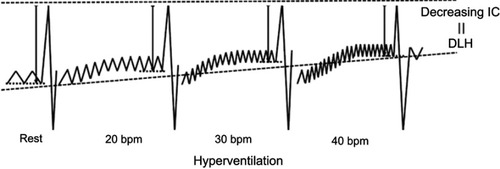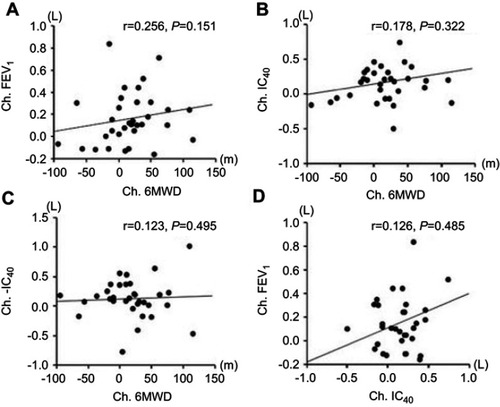Figures & data

Figure 1 Method for measuring dynamic lung hyperinflation by hyperventilation.
Abbreviations: IC, inspiratory capacity; bpm, breaths/min; DLH, dynamic lung hyperinflation.

Figure 2 Details of dynamic lung hyperinflation measurement method using spirometer.
Abbreviations: IC, inspiratory capacity; bpm, breaths/min; ICrest, IC at rest; IC20, IC at 20 bpm; IC30, IC at 30 bpm; IC40, IC at 40 bpm.

Table 1 Characteristics of patients and comparison of lung function before and after treatment
Table 2 Comparison of dynamic lung hyperinflation following hyperventilation and 6-min walking test (6MWT) before and after treatment
Figure 3 Comparison of dynamic lung hyperinflation following hyperventilation before and after treatment. *P<0.05 vs before combined treatment with tiotropium and olodaterol.
Abbreviations: Tio, Tiotropium; Olo, Olodaterol; IC, inspiratory capacity; bpm, breaths/min; ICrest, IC at rest; −IC20, decrease in IC from ICrest to IC at 20 bpm; −IC30, decrease in IC from ICrest to IC at 30 bpm; −IC40, decrease in IC from ICrest to IC at 40 bpm.

Table 3 Correlation of changes in DLH, FEV1, exercise tolerance, and dyspnea with treatment
Figure 4 Correlations of changes in value associated with treatment between 6MWD and FEV1(A), IC40 (B) or −IC40 (C) and between IC40 and FEV1(D). IC40, inspiratory capacity (IC) following 30-s hyperventilation at 40 breaths/min; −IC40, change in IC at rest to IC40.The value of change associated with treatment was calculated as the post-value minus the pre-value.
Abbreviations: Ch, change in value by treatment; FEV1, forced expiratory volume in 1 s; 6MWD, 6-min walking distance; IC, inspiratory capacity; IC40, IC at 40 breaths/min; −IC40, decrease in IC from IC at rest to IC40.

